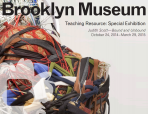
Judith Scott (American, 1943‒2005). Untitled, 2004. Fiber and found objects, 28 × 15 × 27 in. (71.1 × 38.1 × 68.6 cm). The Smith-Nederpelt Collection. © Creative Growth Art Center. (Photo: Brooklyn Museum)

Judith Scott (American, 1943‒2005). Untitled, 2004. Fiber and found objects, 28 × 15 × 27 in. (71.1 × 38.1 × 68.6 cm). The Smith-Nederpelt Collection. © Creative Growth Art Center. (Photo: Brooklyn Museum)

Judith Scott (American, 1943‒2005). Untitled (detail), 2003–4. Fiber and found objects, 56 × 28 × 12 in. (142.2 × 71.1 × 30.5 cm). Creative Growth, Oakland, California. © Creative Growth Art Center. (Photo: Benjamin Blackwell)
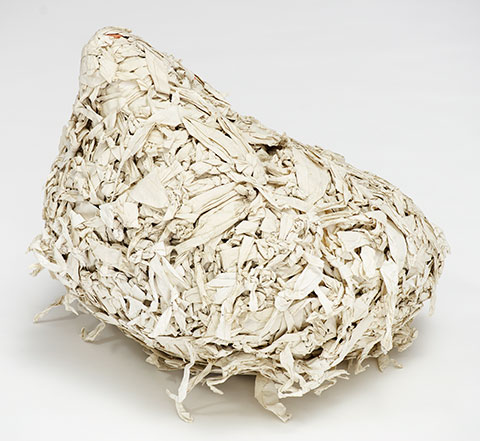
Judith Scott (American, 1943‒2005). Untitled, 1994. Fiber and found objects, 27 × 23 × 17 in. (68.6 × 58.4 × 43.2 cm). Creative Growth, Oakland, California. © Creative Growth Art Center. (Photo: Benjamin Blackwell)
According to the artist-instructor Stan Peterson, who worked closely with Scott at the time, this piece was constructed from torn paper toweling, which Scott retrieved from the restroom or kitchen at Creative Growth when she temporarily found herself without her usual material supplies. It is the only completely monochromatic work she made (though a work from 2004, also included in this exhibition, has a very similar palette, with the addition of a variegated purple spine).
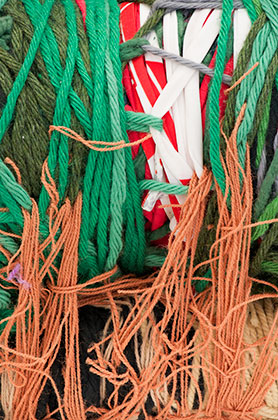
Judith Scott (American, 1943‒2005). Untitled (detail), 2000. Fiber and found objects, 25 × 12 × 10 in. (63.5 × 30.5 × 25.4 cm). Creative Growth, Oakland, California. © Creative Growth Art Center. (Photo: Benjamin Blackwell)
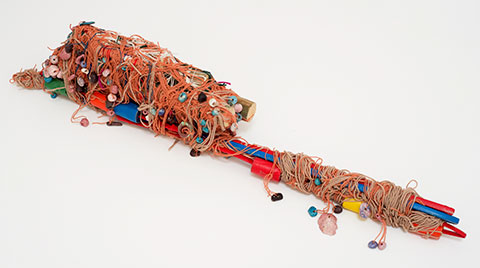
Judith Scott (American, 1943‒2005). Untitled, 1993. Fiber and found objects, 44 × 10 × 10 in. (111.8 × 25.4 × 25.4 cm). Creative Growth, Oakland, California. © Creative Growth Art Center. (Photo: Benjamin Blackwel)
Like Scott’s earliest bundled pieces, this one is a loosely bound construction. It is composed of industrially painted wooden stakes, in primary colors, encased in various yarns and fibers. Attached at regular intervals to the long, horizontal side of the piece, and to the rectangular portion at one end, are dangling beads of various colors and textures, giving the work a sense of possible movement and performative intention.

Judith Scott working at Creative Growth Art Center, 1999. (Photos: © Leon Borensztein)

Judith Scott (American, 1943‒2005). Untitled, 2003–4. Fiber and found objects, 45 × 47 × 31 in. (114.3 × 119.4 × 78.7 cm). Collection of Orren Davis Jordan and Robert Parker. © Creative Growth Art Center. (Photo: Addison Doty, Brooklyn Museum)
Deploying a shopping cart—one of the more difficult-to-disguise found objects Scott incorporated into her work—this is perhaps the most baroque piece the artist made, with its dramatic effect and elaborate woven core. The scale and intricate mass of materials would have required assistance to turn and move the object as Scott worked. The removal of the cart’s two front wheels renders the piece immobile, and thus stabilizes it, while also giving a sense of precarious imbalance.

Judith Scott (American, 1943‒2005). Untitled, 1989. Fiber and found objects, 451⁄8 x 22 × 10 in. (114.6 × 55.9 × 25.4 cm). The Museum of Everything, London. © Creative Growth Art Center. (Photo: © Sylvain Deleu)
By 1989, Scott was experimenting with more elaborately composed works featuring bent and trussed forms, creating a structural tension that is seemingly held in place by her wrapping and weaving technique. Formally, they show an awareness of negative space and sometimes make reference to biological forms amid their elaborate openwork construction.

Judith Scott (American, 1943‒2005). Untitled (detail), 1988. Mixed media on paper, 17 × 11 in. (43.2 × 27.9 cm). The Museum of Everything, London. © Creative Growth Art Center. (Photo: Brooklyn Museum)
Scott made drawings and collages on paper from her earliest days at Creative Growth, months before starting to make three-dimensional objects. Typical in its repetitive, swirling linear gestures with multiple color variations, this work also includes three collaged faces cut from magazines or newsprint, the largest figure being C. Everett Koop, then Surgeon General of the United States. Scott was an avid collector of magazines and other printed materials; she was known to keep magazines on her lap, flipping through them as a break from her work.
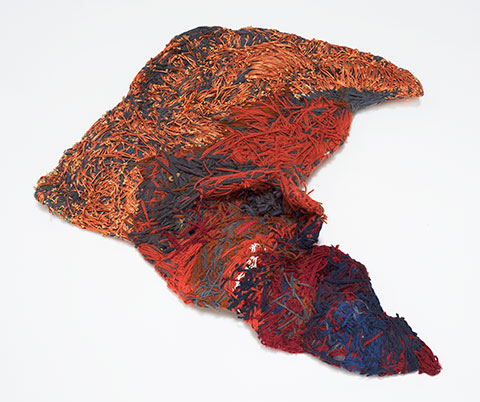
Judith Scott (American, 1943‒2005). Untitled, 1989. Fiber and found objects, 37 × 34 × 5 in. (94 × 86.4 × 12.7 cm). Creative Growth, Oakland, California. © Creative Growth Art Center. (Photo: Benjamin Blackwell)
The combination of color and texture in this piece demonstrates Scott’s increasing sophistication in working with her materials. While in some works the colors are distinct and starkly juxtaposed against each other, others reveal a more subtle mixing and shading of hues.
Scott made her work sitting at a large table in the Creative Growth studio, so that the objects were executed in a horizontal position. Nonetheless, this ambitious work has been shown as a wall relief. Scott constructed a number of pieces with similar relief-like surfaces that, when hung on a wall, feel fluid or imply movement, while when presented horizontally appear more fixed and grounded.

Judith Scott—Bound and Unbound
October 24, 2014–March 29, 2015
Judith Scott’s work is celebrated for its astonishing visual complexity. In a career spanning just seventeen years, Scott developed a unique and idiosyncratic method to produce a body of work of remarkable originality. Often working for weeks or months on individual pieces, she used yarn, thread, fabric, and other fibers to envelop found objects into fastidiously woven, wrapped, and bundled structures.
Born in Columbus, Ohio, with Down syndrome, Scott (1943–2005) was also largely deaf and did not speak. After thirty-five years living within an institutional setting for people with disabilities, she was introduced in 1987 to Creative Growth Art Center—a visionary studio art program founded more than forty years ago in Oakland, California, to foster and serve a community of artists with developmental and physical disabilities.
As the first comprehensive U.S. survey of Scott’s work, this retrospective exhibition includes an overview of three-dimensional objects spanning the artist’s career as well as a selection of works on paper.
Judith Scott—Bound and Unbound is organized by Catherine J. Morris, Sackler Family Curator for the Elizabeth A. Sackler Center for Feminist Art, Brooklyn Museum, and Matthew Higgs, artist and Director/Chief Curator of White Columns, New York. The accompanying catalogue is published by the Brooklyn Museum and Prestel.
This exhibition is made possible by the Elizabeth A. Sackler Foundation. Additional generous support has been provided by the Helene Zucker Seeman Memorial Exhibition Fund and Deedie Rose.
